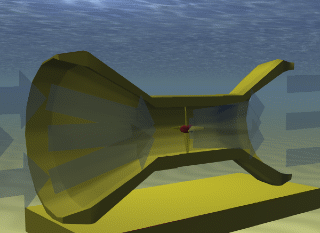Tidal Device Principles
Tidal devices exploit kinetic energy in the tidal flow of water caused by the interaction of the gravitational fields of the earth, moon and sun. Tidal currents are magnified by topographical features, such as headlands, inlets and straits, or sea bed channels. Many of the devices that use these currents are broadly similar to submerged wind turbines. Sea water is around 800 times denser than air but average flow speeds for viable projects are of the order of one fifth of corresponding wind speeds, giving a power density of around 5-10 times. This means that for a tidal device of the same rating as a wind turbine, the rotor will be smaller. Individual tidal devices are unlikely to reach the same rated power as offshore wind turbines; however, as to have sufficient space to deploy such large devices requires development of deeper water sites that generally have less significant tidal flows. EMEC has identified four main types of tidal energy convertors that are outline below.
Tidal energy device concepts (graphics courtesy of EMEC).
Disclaimer
TO DOWNLOAD THIS FILE, YOU MUST AGREE TO THE TERMS AND CONDITIONS "TERMS" NOTED AT THE FOOT OF THIS WEBSITE WHICH APPLY TO YOUR USE OF THIS WEBSITE AND TO USE OF THE FILE YOU HAVE CLICKED TO DOWNLOAD. IF YOU DO NOT AGREE TO THE TERMS, YOU WILL NOT BE ABLE TO DOWNLOAD THE FILE AND YOU SHOULD NOT USE THIS WEBSITE. TO CONFIRM YOUR ACCEPTANCE OF THE TERMS AND TO COMMENCE THE DOWNLOAD OF THE FILE, PLEASE CLICK THE "DOWNLOAD" CHECK BOX. IF YOU DO NOT AGREE TO THE TERMS, PLEASE CLICK THE "CANCEL" BUTTON. YOUR ATTENTION IS DRAWN TO CONDITION 3 NOTED BELOW WHICH FORMS PART OF THE TERMS IN RELATION TO OUR LIABILITY TO YOU.
Agree and download Cancel








